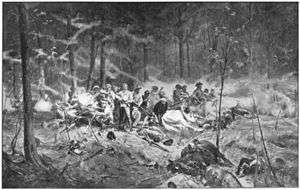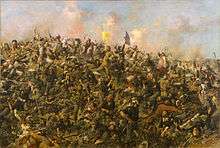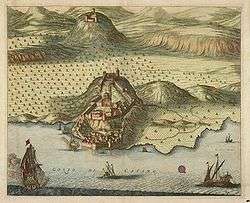Last stand

A last stand is a general military situation in which a body of troops holds a defensive position in the face of overwhelming odds. The defensive force usually takes very heavy casualties or is completely destroyed, as happened at the Battle of Thermopylae in 480 BC, the Fall of Constantinople in 1453, the Battle of Waterloo in 1815, the Battle of Shiroyama in 1877, the Battle of the Little Bighorn in 1876,[1] the battle of Pavankhind, Battle of Saragarhi in 1897 and the Battle of Karbala in 680 . In some cases, troops will make a last stand to protect their ruler or leader. Last stands loom large in history, as the heroism and sacrifice of the defenders exerts a large pull on the public's imagination. Some last stands have become a celebrated part of a fighting forces' or a country's history.
Tactical significance

A "last stand" is a last resort tactic, and is chosen because the defending force realizes the benefits of fighting outweigh the benefits of retreat or surrender. This usually arises from strategic or moral considerations, leading defenders to conclude that their sacrifice is essential to the greater success of their campaign or cause, as happened at the end of the Battle of Thermopylae.[2][3] The situation can arise in several ways. One situation is that retreat by the defending force would lead to immediate defeat, usually due to the surrounding geography or shortage of supplies or support, as happened to the Royalist infantry on Wadborough Hill after the Battle of Naseby.[4][5]

Specifically, defeat or withdrawal by the defending force may give the attacking force a point of utmost tactical importance, making it imperative that the defending force hold its position at all costs. The historian Bryan Perrett suggests that although the majority of last stands throughout history have seen the defending force overwhelmed, on rare occasions the outnumbered defenders succeed in their desperate endeavours and live to fight another day, and he lists the Battle of Agincourt and the Battle of Rorke's Drift as such engagements,[6] Another example could be the Battle of Myeongnyang, where 13 Joseon Navy warships (led by Korean admiral Yi Sun-sin) defeated 133 Japanese warships,[7] as well as battles such as Siege of the International Legations, the Battle off Samar and the Raid on Godfrey Ranch.
In some cases, troops will make a last stand to protect their ruler or leader. When Rome was attacked in 1527 by the army of the Holy Roman Empire under Emperor Charles V, over 20,000 troops stormed the city. The 189 Swiss Guards made a last stand against the massive army by forming a square around St. Peter's Basilica to give Pope Clement time to escape through secret tunnels. The Swiss Guard held the doors until Clement could escape. In the Battle of Hastings in 1066, Saxon King Harold II battled the Norman William the Conqueror, who invaded with 7,000 men. After the most of the Saxons were killed in the battle, "Harold and his housecarl bodyguard...fought on until an arrow struck the king in the eye." After Harold died, the housecarl bodyguard made a last stand and "...fought to the death around the body of their dead king."[8]
Some last stands have become a celebrated part of a fighting force or country's history. The French Foreign Legion became known for its last stand in the 1863 Battle of Camarón. During the battle, 65 Foreign Legion troops protecting a supply convoy carrying gold bullion were attacked by a Mexican force of 3,000 soldiers. The Foreign Legion soldiers fought their way to a building, which they used as a defensive position for their last stand. They refused to surrender, and fought until almost all of the Legion troops were killed. When only a handful of troops were still alive, with no ammunition left, they conducted a bayonet charge at the much larger Mexican force. April 30 is called Camerone Day in France to remember this day, and the last stand is a celebrated part of the French Foreign Legion's history. In the Battle of the Alamo (February 23 – March 6, 1836) 1,500 Mexican soldiers attacked the Alamo in Texas, which was defended by 180 to 260 Texans. Between 182 and 257 Texians died in a last stand defense of the Alamo. The Texians' last stand in this battle has become a celebrated part of US history, which has been depicted in numerous films.
Sometimes, rather than face annihilation at the hands of a pursuing victorious army, a rearguard will be tasked by the commander of the defeated army with hindering the advance of the victorious army. Even if the rearguard is destroyed in a last stand, its sacrifice may buy their commander time to disengage without losing the majority of his army as happened during the Battle of Roncevaux Pass (778), Battle of Stamford Bridge (1066), and the Dunkirk evacuation (1940, in World War II).[9][10][11]
A last stand may also be the last pitched battle of a war where the position of the defending force is hopeless but the defending force considers it their duty not to surrender until forced to do so, as happened to the last Royalist field army of the First English Civil War at the Battle of Stow-on-the-Wold.[12]
At the end of a siege

A siege may lead to a last stand by the defenders (see for example the Battle of the Alamo).[13] Last stands at the end of sieges became less common after the Hague Conventions came in force. Before the 20th century, if a besieged garrison refused any offered terms of surrender and the attackers subsequently breached the defences, the defenders were only given quarter at the discretion of the attackers, something they were not likely to do if they perceived that by holding out, with no hope of relief, the defenders had needlessly squandered lives. Under the laws of war as they are now "...it is especially forbidden - ... To kill or wound an enemy who, having laid down his arms, or having no longer means of defence, has surrendered at discretion; [and] To declare that no quarter will be given ...",[14] it is unlawful for an attacking force to kill a garrison if they attempt to surrender even if it is during the final assault on a fortified position.
Historical significance
Last stands loom large in history due to the pull on popular imagination. Historian Nathaniel Philbrick argues:
Long before Custer died at the Little Bighorn, the myth of the Last Stand already had a strong pull on human emotions, and on the way we like to remember history. The variations are endless — from the three hundred Spartans at Thermopylae to Davy Crockett at the Alamo — but they all tell the story of a brave and intractable hero leading his tiny band against a numberless foe. Even though the odds are overwhelming, the hero and his followers fight on nobly to the end and are slaughtered to a man. In defeat the hero of the Last Stand achieves the greatest of victories, since he will be remembered for all time.[15]
See also
- List of last stands
- Battle of Thermopylae
- Siege of Masada
- Battle of Roncevaux Pass
- Battle of Saragarhi
- Custer's Last Stand
- Battle of Wizna
- Battle of Westerplatte
- Fall of Constantinople
- Battle of Stamford Bridge
- Battle of Rorke's Drift
- Battle of Naseby
- Battle of Myeongryang
- Dunkirk evacuation
- Battle of Stow-on-the-Wold
- Battle of the Alamo
- Battle of Imjin River
- Battle of Pavan Khind
- Battle of Shiroyama
- Battle of Berlin
- Battle off Samar
- Siege of Bastogne
- Siege of Szigetvár
- Battle of Pasir Panjang
- Battle of Camaron
- Sack of Rome (1527)
- Rezang La
References
- ↑ Sandler, Stanley (2002). Ground warfare: An International Encyclopedia. International warfare encyclopedias from ABC-CLIO. 1 (illustrated ed.). ABC-CLIO. pp. 506,507. ISBN 1-57607-344-0.
- ↑ Rollin, Charles (1804). The ancient history of the Egyptians, Carthaginians, Assyrians, Babylonians, Medes and Persians, Macedonians, and Grecians. 3 (10 ed.). Printed for W. J. & J. Richardson. p. 34.
- ↑ Hamm, Jean Shepherd. Term Paper Resource Guide to Medieval History. Greenwood (November 25, 2009). pp. 88-90. ISBN 978-0313359675
- ↑ David Plant 1645: The Storming of Leicester and the Battle of Naseby, www.british-civil-wars.co.uk, Retrieved 2009-05-24
- ↑ Martin Marix Evans, Graham Turner. Naseby 1645: The Triumph of the New Model Army,, Osprey Publishing, 2007 ISBN 1-84603-078-1, ISBN 978-1-84603-078-9. p. 76
- ↑ Bryan Perrett. Last Stand!: Famous Battles Against the Odds. p. 9
- ↑ Sŏng-nyong Yu (translated by Byonghyon Choi), 2002, The Book of Corrections: Reflections on the National Crisis During the Japanese Invasion of Korea, 1592-1598: Institute of East Asian Studies, University of California, Jan 1, 2002, p. 129
- ↑ http://listverse.com/2009/08/28/10-heroic-last-stands-from-military-history/
- ↑ Hamm, Jean Shepherd. Term Paper Resource Guide to Medieval History. Greenwood (November 25, 2009). pp. 88-90. ISBN 978-0313359675
- ↑ Last of the Vikings – Stamford Bridge, 1066 (History)
- ↑ John Harris, Dunkirk: "the storms of war", David & Charles, 1980, ISBN 0-7153-7857-0, ISBN 978-0-7153-7857-1. p.8 "Dunkirk was a military operation also — a hard-fought retreat with a magnificent last stand by the rearguard to allow the bulk of the troops to get [away]"
- ↑ Sidney Low, et al., The dictionary of English history, Cassell and company, 1928. "At the battle of Naseby Astley commanded the infantry, and in 1646 he made a last stand at Stow-on-the-Wold against the Parliament."
- ↑ Gunderson, Cory Gideon (2004). The battle of the Alamo. ABDO. p. 15. ISBN 1-59197-278-7.
- ↑ IV Hague Convention. The Laws and Customs of War on Land October 18, 1907. Article 23
- ↑ Philbrick, Nathaniel. The Last Stand: Custer, Sitting Bull, and the Battle of the Little Bighorn. New York: Viking Books, 2010, p. xvii.